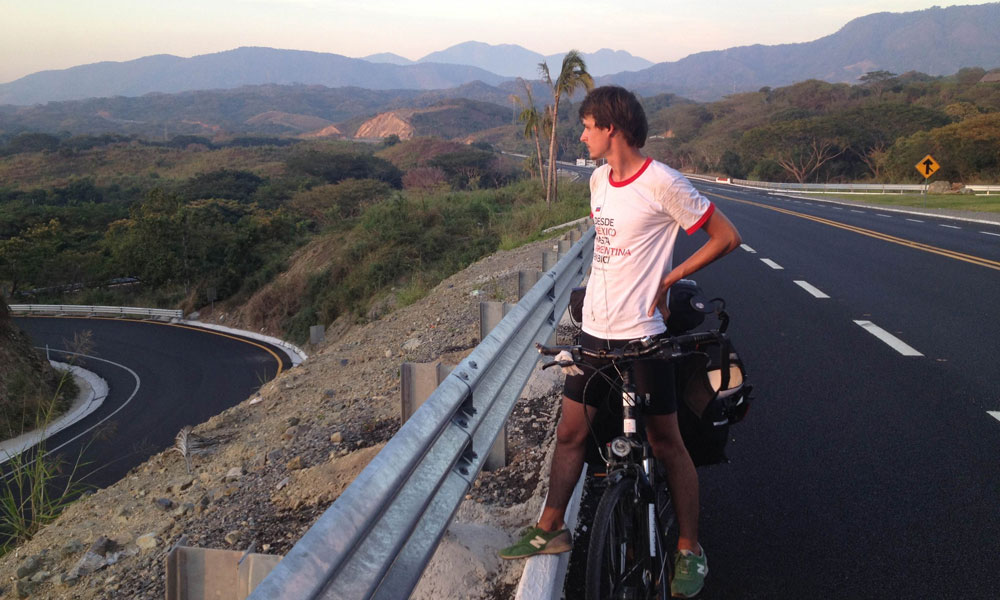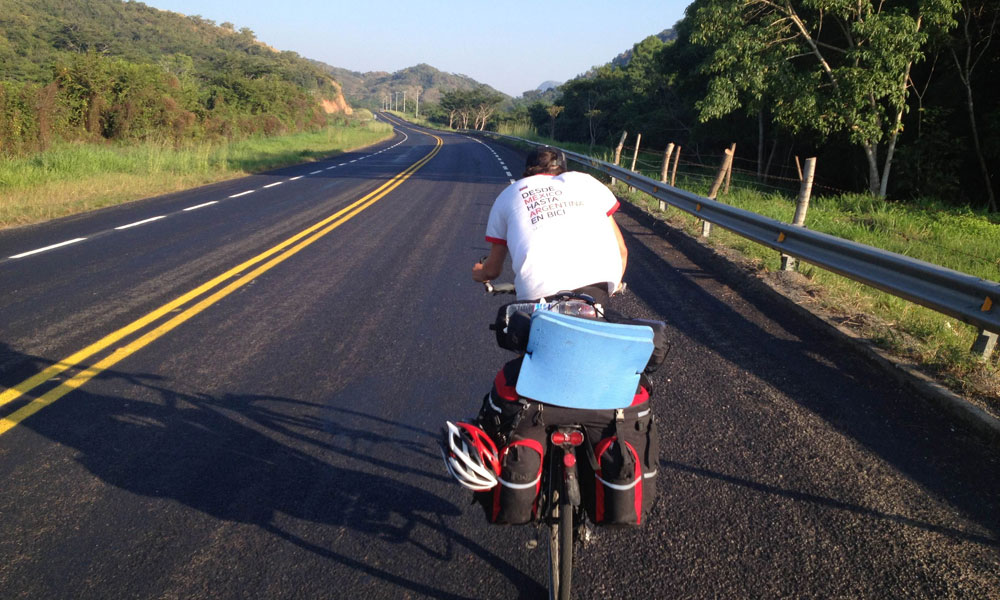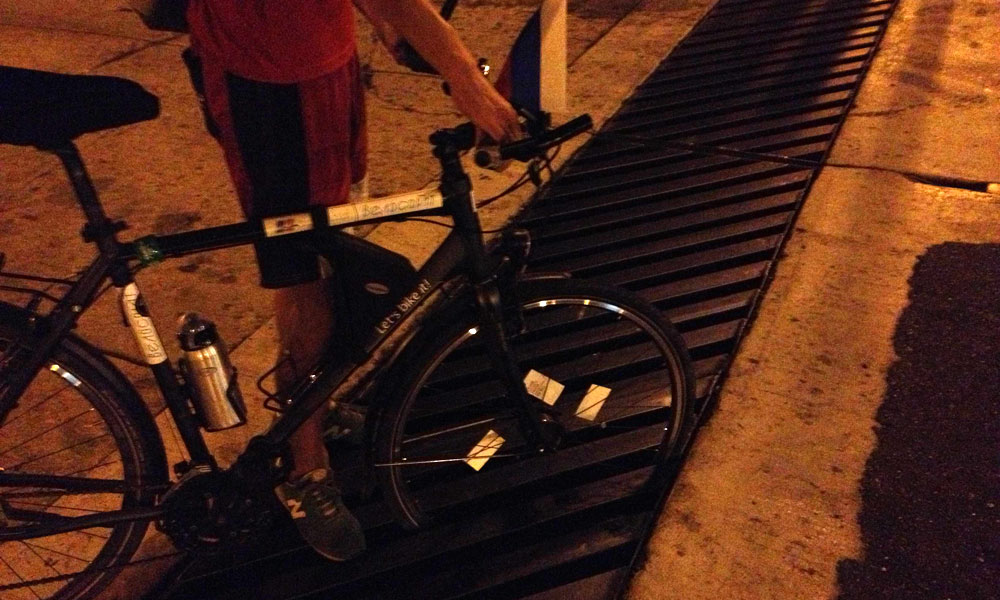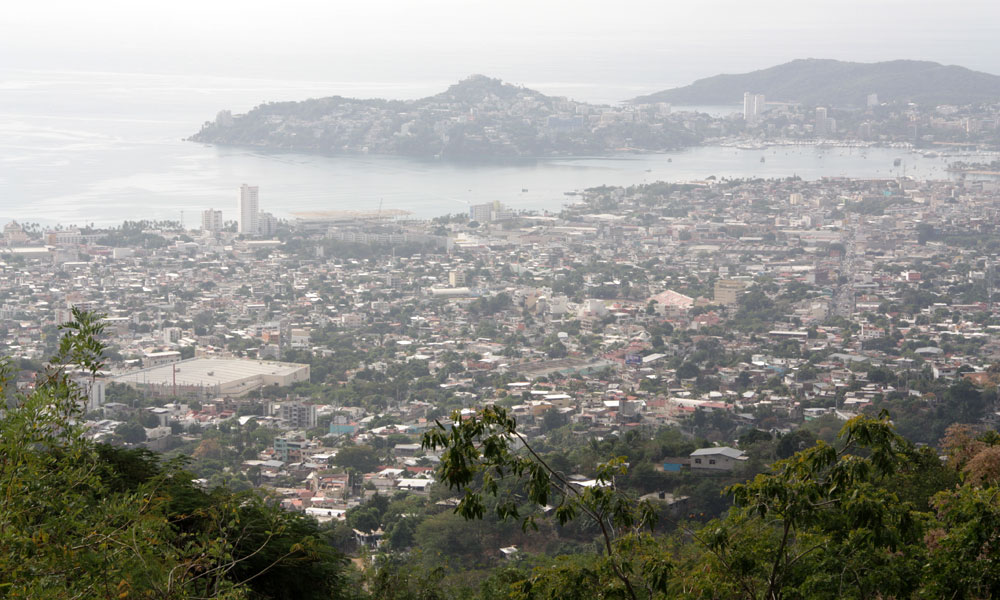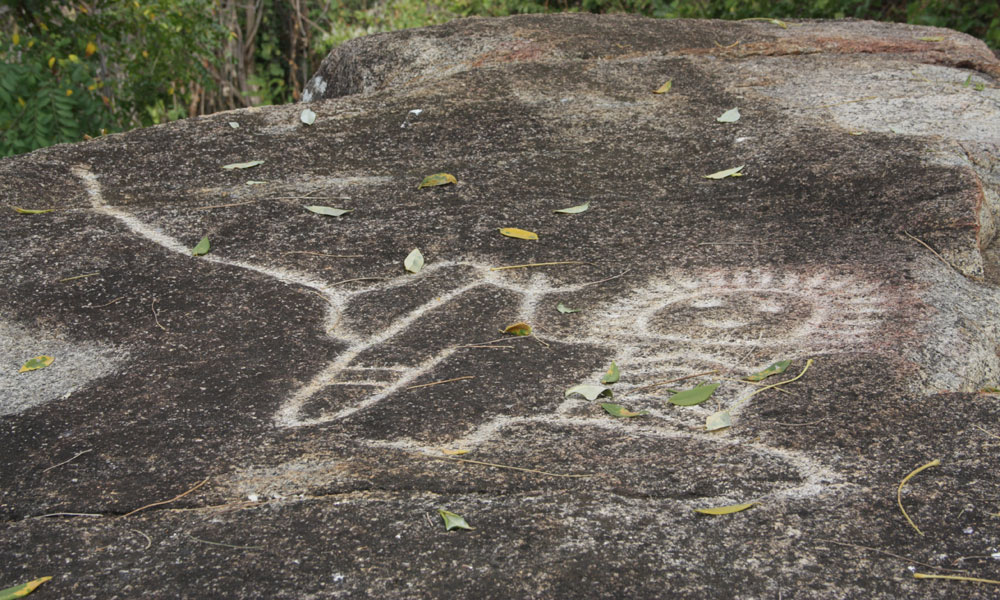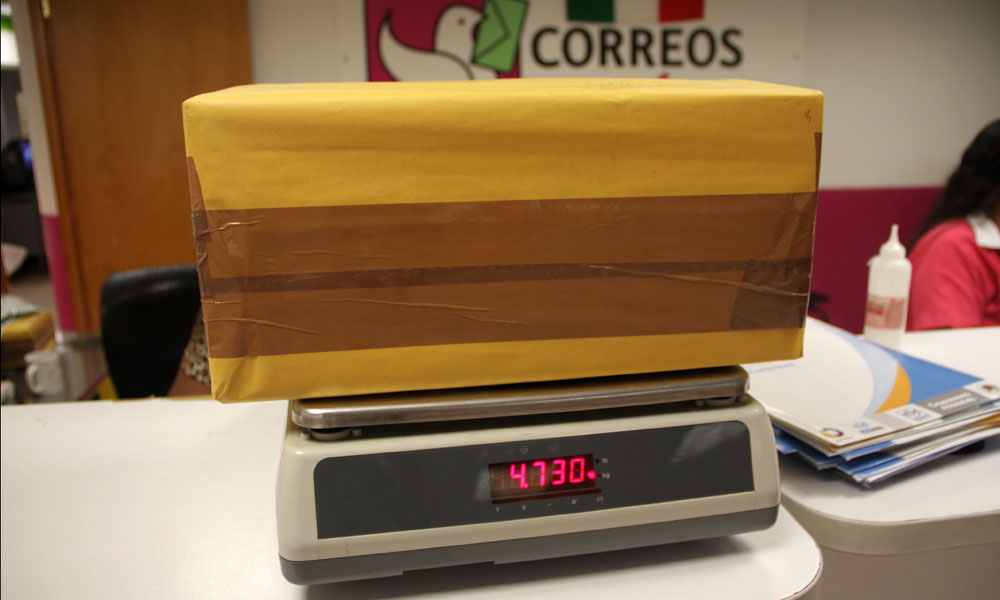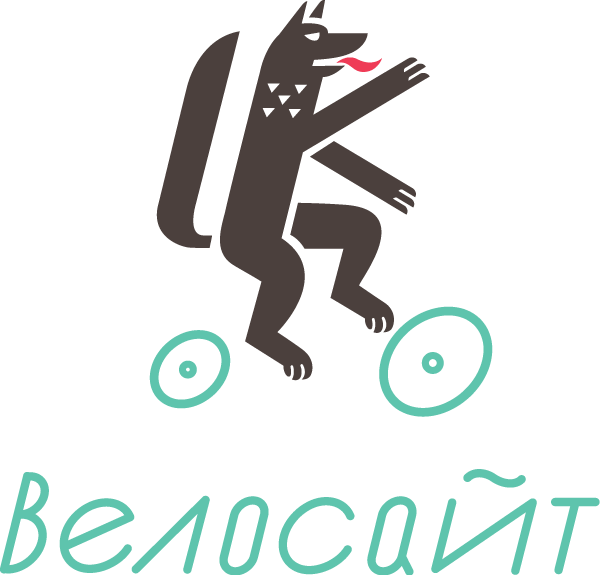How we visited the drug dealers’ city, tasted Mexican watermelons and unexpectedly found ourselves in Buenos Aires.
We spent two days in Lazaro Cardenas. It is a small, not quite picturesque port city with terrible roads. However, there was the Internet, therefore we stayed – we had to write letters to “Let's bike it!” collaborates about cooperation in the next year, to complete the site and to bring out the post. And we still had to find a couch (free housing) in cities along the route for the next few days. We found lodging by couchsurfing in Acapulco, so it had become our next purpose. After difficult 280 km around the state of Michoacán, which we had passed rather slowly, we intend to overcome the distance of 340 km to Acapulco as soon as possible. The map showed that in general the road became easier and wasn’t zigzagging.
Day 12.
While we were waiting for the green light at the intersection, an elderly Mexican approached to us. He saw the flag on the bike and asked where we were going. He told that he works in the traffic police and never seen a Russian in this area. We gave him our visiting card, and he promised that he would pass to the traffic police on our way to “look after” us. In Mexico, the police and the military rather curiously patrol roads, but that's another story.
We quite easy got out of Lazaro Cardenas. The road was empty and with the roadside verge. Already in the very first kilometers on the highway the camera on a Vova’s bicycle was struck. On that day, we didn’t suspect that beaten cameras would haunt us soon.
Having passed a little, we crossed the state of Michoacán border and entered the State of Guerrero. Asphalt was pleasant — we were finally able to keep the speed of 25-30 km per hour. There were also less climbs, and if there were, the road wasn’t even wagged, and went straight. Nevertheless, the scorching sun didn’t disappear.
By the evening we reached the resort town, Zihuatanejo. There were a lot of hotels and beach. If we had known this in advance, we probably would prefer to make a stop here, not in Lazaro Cardenas.
At the first quite inexpensive hotel was a tiny pool. When you all day dreaming about a cold shower, the thought about the pool gives the feeling close to happiness. Of course, we stayed there!
Day 13.
While we were fixing our bags on the bicycle carrier, hotel manageress came and once again convinced us that Mexicans calculate the distances in vehicle-hours.
— Where are you planning to get today?
— We are going in the direction of Acapulco, but still don’t know where we will stay for the night.
— Why? It’s just three hours away from here to Acapulco!
— Uh ... Yeah, but it's by car!
— o_O
Some of the roads were mended. Sometimes we had to overcome the hard-packed sand, prepared for the new asphalt. This didn’t slow us much, but there was quite dusty because of the passing cars. Sometimes we had to ride off-road, screw up our eyes and barely breathing.
As a reward for our suffering we made a stop at a cafe on a hill with a wonderful view of the ocean. There hadn’t been any menu, however we explained by words and found that there were a fish and it was cheap. So we got it.
— Spanish-language Wikipedia
Before dark we had managed to reach San Luis de la Loma, the small town with 11 thousand citizens. That time we didn’t know that in Mexico this city is very famous for its “criminal life”. Later, Luis Miguel’s friend, who hosted us in Acapulco, told that it‘s one of the major points of drug traffic.
We didn’t like that city right off, because the locals paid us a lot of attention in a special way. Almost at every shop and eatery we heard shouting: “What's up, gringo?”, then something unintelligible in Spanish that caused laughter of locals. It is not unusual when country people welcome, waving their arms and shouting something like “Hello my friend”, but there was not really friendly and too much attention.
We stopped at a gas station and asked a local driver about roadside motels within 20 kilometers of city. He shook his head and offered to put up a tent near a small river. He added that we could have a wash in the river. We had no desire to spend the night there in the open.
We had no choice but to stay in one of the two hotels, which were on the same street. Both looked equally bad, and we chose the one that was cheaper. It was the worst room we have ever stayed.
By the way, rooms of cheap hotels in Mexico could have no towels, a toilet paper and seat, mirrors, hot water, fans, and any furniture except beds. However TV is always there!
Day 14.
At the beginning of the day we never knew where we could be at night. It is impossible to predict reliefs, roads, a heat, emergency situations and sudden fatigue. In spite of everything we were aimed to Acapulco, so we left earlier than usual.
It was a particularly hot day. Setting the record on distance, we delivered another record on drinking fluids — about 16 liters. In addition we even ate watermelon – the embodiment of a two-day dream.
Almost at any village, along the highway we saw locals selling their farm products. But products varied each day. For example, you can ride all day and see only coconuts, the next day – only corn and in some other day- only watermelons. It was the same with restaurants. If we wanted meat there was only seafood along the coast, and vice versa.
We pulled up to the tent. A young woman was talking to a lad and didn’t see us.
— How much is a watermelon?
— 10 pesos.
Then she turned around and recognized that we are foreigners:
— 15 pesos.
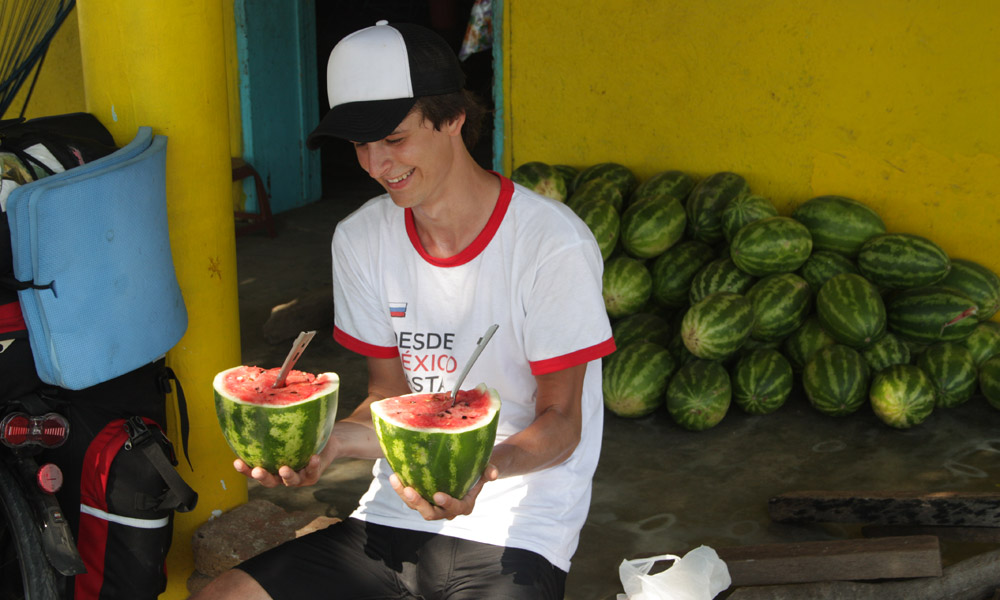
Than we arrived at the village called Buenos Aires – the same as our final destination in Argentina. Joking about it, we continued our journey in a good mood.
There remained an hour before dark, when we reached the town located in 30 km from Acapulco. We didn’t intend to retreat, despite the twilight. Although, twilight is the most comfortable time to ride, we couldn’t say that after 110 km we reached these 30 km easily. However it wasn’t difficult either, because we felt the approach of the famous resort. Rest of the path we sang aloud songs about Acapulco and joined in a song of Cumbias which played at top volume, shocking Mexicans on our way.
The only ones hard hills over the past few days were waiting for us right at the entrance to Acapulco. The last 10 km we rode up and down in the increasing traffic.
Then we came abreast of a car and man peeped out the window, wondering in Russian, if we were Russians indeed? He offered to stop on the sidelines. We didn’t happen to meet fellow countrymen since we left Mexico. Out of the car came three: one lives there, and two of his friends came to visit from Vladivostok. We talked about our adventure, got their approval, handed a visiting cards and rode on. Then they caught up with us again at a crossroads and suggested best way to the center.
We had to wait until 11 pm, when Luis Miguel would get free, and intended to stay in his apartment. We had dinner and went to drink wine on the waterfront, then talked with an elderly Canadian and with a writer from U.S. Luis Miguel turned up only at half past midnight, but 7 hours of conversations flew by.
Days 15-18.
We don’t think that among our readers there are some who have never heard about Acapulco. This resort was popular in the 50-70's among Hollywood stars and millionaires, glorified in dozens of songs and starred in the classic film. Probably getting to such places of worship, expectations may exceed reality. It was so with us...
The first impression was rather ambiguous. There were neat beaches, luxury skyscraper-hotels on the coast, boutiques and restaurants to fit any taste, night clubs and casinos — not without reason Acapulco considered the center of nightlife and entertainment in Mexico. On the other hand, if you move a little away from the main street, you get in poor quarters: dilapidated houses, drunks and beggars, garbage, traffic and roads unrepaired since the 50's.
Acapulco is located at the foot of the hill. The central street bends around the ocean bay and this is the same street where all entertainments are located. The rest of the city “hangs” over the bay from the mountain, so all the radial streets are in a very steep climb from the waterfront. Cycling around the city along the radial streets is almost impossible, because the slope of the road is 15-20 degrees (we measured it using the gyroscope in the phone). It is suitable only for transporting the bike as luggage — simply drag up the bike than ride it. Besides, down you have to “creep”, almost totally shutting the brakes.
In these streets there are sett paved roads or PCP roads with relief coatings, therefore the parked cars are not rolling down. No wonder that at the network of Mexican cycling communities (Bicired) Acapulco presented by cycling community AcaMTB (Acapulco Mountain Bike).
We lived at the apartment in the house on the western headland of the bay near the main promenade. But the last 200 meters of the road to the house were steeply uphill. At one site gyroscope showed slope of 22 degrees.
Upon arrival to Acapulco we were met by Luis Miguel. He drove the car, asked to follow him and suggested to help with transportation of our bags. I wish we didn’t refuse. But we did, because didn’t know what a steep climb was waiting for us. We pushed the bikes on foot. Until that day we hadn’t been sweating after sunset.
Luis Miguel’s apartment had only one room with a bed, therefore for overnight in our possession was a huge balcony overlooking the ocean. All the days we spent in Acapulco night temperature kept around 25 degrees, so we slept in sleeping bags, not even hiding. We got up at the crack of dawn without an alarm, as it was getting very hot.
The heat in Acapulco is all the year round. Within the walls of houses even specifically provided patterned holes for ventilation. Although it didn’t help us — it was still stuffy. in spite of everything — no matter what. 10 minutes after a nice cold shower and all over again it became unbearably hot.
In Acapulco and in all major cities of Mexico, including Mexico City and Guadalajara, are very common gully gratings on the roads. And this is a serious danger to cyclists. Gully gratings rank stand in line across the whole width of the roadway, therefore you can’t avoid it. Each grating has the spans, where the bicycle wheel, even with wide tires “founder” in half. If grate bars hasn’t an angle of 45 degree, it would be impossible to overcome such parts of the road in a straight line.
Climbing a way to the house was the only inconvenience; therefore we still rode to the center by bicycle. One evening on the way to the house Vladimir turned at the intersection and failed to steer the handlebar, so the wheel had wallowed in gully grating. We rode not fast and didn’t fall, just bicycle stuck up “out of the earth” and the camera had broken from impact. Not to damage the tire we rolled the bike on the back wheel in turns.
Unpleasant incident had been forgotten, as soon as we got home. Luis Miguel’s guests offered us a beer and to join the conversation. We discussed a lot, mostly about assumption differences of Russians and Mexicans. When the conversation turned to vodka, we had been informed that a bottle of “Stolichnaya” here costs more than 1000 rubles and they think it’s one of the best vodka. Then we talked about politics and complicated “friendly” relations between the U.S. and Mexico. U.S. constantly pressed on the war on drug spread issue, but at the same time the country legalized soft drugs. Mexico is banned to produce gasoline; therefore the country is forced to sell all produced oil to the U.S. and to buy the more expensive gasoline. We talked about the military, which were driving on highways in trucks and jeeps with machine guns atilt. It seemed that the war started, actually as it turned out this was just for “comfort of the community”.
In the morning Luis Miguel took us to the archaeological dig, located on a hill overlooking the entire city and the bay. There we saw a small and almost unpopular among tourists, but still pretty interesting “collection of paintings” at the huge rocks, which had left over from eldest nations. They were living in the area before the arrival of Europeans.
Acapulco shows up much by its cheerful public transport. Massive high buses resemble American trucks. These buses dressed up as a Christmas tree and loud music from them is usually extended to the entire street. They were colorful, with bright illumination, with all kinds of airbrushing, fake spikes on shiny wheel rims and all sorts of hand-made from the drivers. Every was different and looked like a museum exhibit. It seemed we were on an excursion, like inside Moscow metro. Even advertising on buses looked awesome and it made us consider each detail.
Also in Acapulco are a lot of taxis. According to the serial number on the body, there are about 10,000. It’s proper for a city with a population of 650 thousand people. Almost all taxis in the city are equally painted old-fashioned Volkswagen Beetles from old-world. They are almost more than the rest of the transport, and in the stream they are scamper like ants. Although taxis are municipal, they haven’t got fare register. So you can bargain with the driver until he agrees to your price. The half-hour trip to the 9 km of traffic jams cost us 100 rubles, although initially the driver asked twice as many.
We had spent three days in Acapulco. All this time we were doing the site, Russian part of Let's bike it! Also we were solving the problems with the visa to Costa Rica. Despite that we had been living by the ocean and working in a cafe on the main promenade, in 100 meters from the beach, we not even once went swimming. Another important thing we had made in Acapulco was a hike to the post office. We sent unnecessary things to Moscow and our bags became lighter almost on 5 kilograms.
The night before we left, walking through the center, I finally was filled with the spirit of Acapulco. There is something attractive and alluring in one's way. Maybe today city hasn’t that bohemian beauty as in old times, but echoes of it are everywhere. You can feel it. This is exactly the city where I want to return. But Vova remained cold to Acapulco, calling it a mix of a busy Moroccan Casablanca and fake Las Vegas.
Translated by: Maria Kushakovskaya
comments powered by HyperComments


